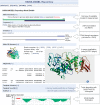The SWISS-MODEL Repository and associated resources
- PMID: 18931379
- PMCID: PMC2686475
- DOI: 10.1093/nar/gkn750
The SWISS-MODEL Repository and associated resources
Abstract
SWISS-MODEL Repository (http://swissmodel.expasy.org/repository/) is a database of 3D protein structure models generated by the SWISS-MODEL homology-modelling pipeline. The aim of the SWISS-MODEL Repository is to provide access to an up-to-date collection of annotated 3D protein models generated by automated homology modelling for all sequences in Swiss-Prot and for relevant models organisms. Regular updates ensure that target coverage is complete, that models are built using the most recent sequence and template structure databases, and that improvements in the underlying modelling pipeline are fully utilised. As of September 2008, the database contains 3.4 million entries for 2.7 million different protein sequences from the UniProt database. SWISS-MODEL Repository allows the users to assess the quality of the models in the database, search for alternative template structures, and to build models interactively via SWISS-MODEL Workspace (http://swissmodel.expasy.org/workspace/). Annotation of models with functional information and cross-linking with other databases such as the Protein Model Portal (http://www.proteinmodelportal.org) of the PSI Structural Genomics Knowledge Base facilitates the navigation between protein sequence and structure resources.
Figures

Similar articles
-
The SWISS-MODEL Repository: new features and functionalities.Nucleic Acids Res. 2006 Jan 1;34(Database issue):D315-8. doi: 10.1093/nar/gkj056. Nucleic Acids Res. 2006. PMID: 16381875 Free PMC article.
-
The SWISS-MODEL Repository of annotated three-dimensional protein structure homology models.Nucleic Acids Res. 2004 Jan 1;32(Database issue):D230-4. doi: 10.1093/nar/gkh008. Nucleic Acids Res. 2004. PMID: 14681401 Free PMC article.
-
The SWISS-MODEL Repository-new features and functionality.Nucleic Acids Res. 2017 Jan 4;45(D1):D313-D319. doi: 10.1093/nar/gkw1132. Epub 2016 Nov 29. Nucleic Acids Res. 2017. PMID: 27899672 Free PMC article.
-
SWISS-MODEL: modelling protein tertiary and quaternary structure using evolutionary information.Nucleic Acids Res. 2014 Jul;42(Web Server issue):W252-8. doi: 10.1093/nar/gku340. Epub 2014 Apr 29. Nucleic Acids Res. 2014. PMID: 24782522 Free PMC article.
-
The Swiss-Prot protein knowledgebase and ExPASy: providing the plant community with high quality proteomic data and tools.Plant Physiol Biochem. 2004 Dec;42(12):1013-21. doi: 10.1016/j.plaphy.2004.10.009. Epub 2004 Dec 15. Plant Physiol Biochem. 2004. PMID: 15707838 Review.
Cited by
-
Missense variants of FBN2 associated with congenital arachnodactyly in three Chinese families.Mol Genet Metab Rep. 2024 Sep 9;41:101140. doi: 10.1016/j.ymgmr.2024.101140. eCollection 2024 Dec. Mol Genet Metab Rep. 2024. PMID: 39310807 Free PMC article.
-
What makes Candida auris pan-drug resistant? Integrative insights from genomic, transcriptomic, and phenomic analysis of clinical strains resistant to all four major classes of antifungal drugs.Antimicrob Agents Chemother. 2024 Oct 8;68(10):e0091124. doi: 10.1128/aac.00911-24. Epub 2024 Sep 19. Antimicrob Agents Chemother. 2024. PMID: 39297640
-
Exploring Lead-Like Molecules of Traditional Chinese Medicine for Treatment Quest against Aliarcobacter butzleri: In Silico Toxicity Assessment, Dynamics Simulation, and Pharmacokinetic Profiling.Biomed Res Int. 2024 Feb 22;2024:9377016. doi: 10.1155/2024/9377016. eCollection 2024. Biomed Res Int. 2024. PMID: 39282570 Free PMC article.
-
Advancing rational pesticide development against Drosophila suzukii: bioinformatics tools and applications-a systematic review.J Mol Model. 2024 Sep 2;30(9):319. doi: 10.1007/s00894-024-06113-w. J Mol Model. 2024. PMID: 39222282 Review.
-
Rhodoquinone-dependent electron transport chain is essential for Caenorhabditis elegans survival in hydrogen sulfide environments.J Biol Chem. 2024 Sep;300(9):107708. doi: 10.1016/j.jbc.2024.107708. Epub 2024 Aug 22. J Biol Chem. 2024. PMID: 39178951 Free PMC article.
References
-
- Manjasetty BA, Turnbull AP, Panjikar S, Bussow K, Chance MR. Automated technologies and novel techniques to accelerate protein crystallography for structural genomics. Proteomics. 2008;8:612–625. - PubMed
Publication types
MeSH terms
Grants and funding
LinkOut - more resources
Full Text Sources
Other Literature Sources
Research Materials

